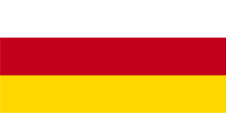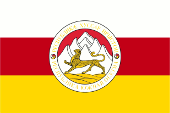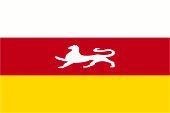Südossetien |
|
|
|
| Übersicht – Contents: | |
Südossetien |
|
|
|
| Übersicht – Contents: | |
Flaggen – Flags: |
|
 |
seit/since 1990, Nationalflagge – national flag, Seitenverhältnis – ratio = 1:2, Quelle/Source, nach/by: Flags of the World, Wikipedia (RU) |
 |
Flagge des Präsidenten – flag of the President, Seitenverhältnis – ratio 2:3, Quelle/Source, nach/by: Flags of the World, Wikipedia (RU) |
historische Flagge – historical Flag: |
|
 |
1991–1992, Flagge der Nationalgarde – flag of National Guard, Seitenverhältnis – ratio 2:3(?), Quelle/Source, nach/by: Wikipedia (RU), vexillographia.ru |
| Die Flagge Südossetiens zeigt drei waagerechte Streifen in Weiß, Rot und Gold. Die Flagge orientiert sich an der Gestaltung der Flagge Nordossetiens, welches im Norden an Südossetien grenzt, jedoch zu Russland gehört. Das Erscheinungsbild der Flagge wurde mit der Verordnung "Über die Staatsflagge der Republik Südossetien" per Beschluss des Obersten Sowjets der Republik Südossetien vom 30. März 1992 erstmalig geseztlich geregelt. Eine Bestätigung erfolgte durch das Verfassungsgesetz der Republik Südossetien "Über die Staatsflagge der Republik Südossetien" vom 28. Februar 2019. Die Farben sind auch im Pantone Farbspektrum festgelegt: Rot = pt 186 c, Gelb = pt 012 c. Die Farbe Weiß und steht für Reinheit und Edelmut, Rot steht für Mut, Stärke und Ehre, Gelb steht für Fülle, Wohlbefinden und Wohlstand. Sie Farben und auch deren Bedeutung gehen auf die drei Nart-Clans im alten ossetischen Nart-Epos aus dem 8. Jahrhundert zurück. Die Osseten sind Nachkommen des persischen Volkes der Alanen. Zu den weiteren Flaggen des Landes gibt es nur wenige Fotos aber auch viele Unklarheiten. Ein Foto zeigt den Präsidenten des Landes mit der Trikolore, jedoch zeigt diese in der Mitte das runde Wappen des Landes in einer reduzierten Form. Es könnte sich um die Flagge des Präsidenten handeln. Es gibt noch eine weitere Flagge vom Anfang der 90-er Jahre des 20. Jahrhunderts, die häufig als die Flagge Südossetiens angesehen wurde. Sie zeigt in der Mitte des roten Streifens die Silhouette eines Schneeleoparden. Hierbei handelte es sich um eine Flagge, die Angehörige der Nationalgarde in Privatinitiative geschaffen haben. |
The flag of South Ossetia
features three horizontal stripes in white, red and gold. The flag is based
on the design of the flag of North Ossetia, which borders South Ossetia to
the north but belongs to Russia. The appearance of the flag was legally regulated for the first time with the regulation "On the State Flag of the Republic of South Ossetia" by resolution of the Supreme Soviet of the Republic of South Ossetia from 30th of March in 1992. A Confirmation was made by the Constitutional Law of the Republic of South Ossetia "On the State Flag of the Republic of South Ossetia" from 28th of February in 2019. The colours are also established in the Pantone color spectrum: red = pt 186 c, yellow = pt 012 c. The colour white stands for purity and nobility, red stands for courage, strength and honor, yellow stands for abundance, well-being and prosperity. The colours and their meaning go back to the three clans of the Nart in the old Ossetian Nart-Epos from the 8th century. The Ossetians are descendants of the Persian people of the Alans. There are only a few photos of the country's other flags but there is also a lot of ambiguity. A photo shows the country's president with the tricolour, but in the middle it shows the country's round coat of arms in a reduced form. It could be the president's flag. There is another flag from the early 1990s that was often considered the flag of South Ossetia. It shows the silhouette of a snow leopard in the middle of the red stripe. This was a flag, that members of the National Guard created on a private initiative. |
| Quelle/Source: Wikipedia (RU), vexillographia.ru, Flags of the World, Volker Preuß | |
Wappen – Coat of Arms: |
|
 |
seit/since 1999, Wappen von Südossetien – coat of arms of South Ossetia, Quelle/Source, nach/by: Flags of the World |
| Das Wappen wurde am 19. Mai 1999 angenommen und zeigt einen Schneeleoparden innerhalb einer kaukasischen Landschaft. Es entspricht dem Wappen Nordossetiens, jedoch ist es von einem silbernen Band umgeben, das den Namen der Republik in Ossetisch und Russisch zeigt. Es wurde von dem Künstler Murat Dzhikayev geschaffen. Das Bild geht auf das sogenannte "Banner Ossetiens" zurück, das von einer Skizze von Vakhushti Bagrationi her bekannt ist. Bagrationi war ein georgischer Fürst, Historiker und Geograph des frühen 18. Jahrhunderts, der in Russland gewirkt hat. |
The coat of arms was
adopted on 19th of May in 1999 and shows a snow leopard within a Caucasian
landscape. It corresponds to the coat of arms of North Ossetia, but it is
surrounded by a silver band, showing the name of the republic in Ossetian
and Russian. It was created by the artist Murat Dzhikayev. The image is
based on the so-called "Banner of Ossetia", which is known from a sketch by
Vakhushti Bagrationi. Bagrationi was a Georgian prince, historian and
geographer of the early 18th century who worked in Russia. |
| Quelle/Source: Wikipedia (RU) | |
| Landkarte – Map: |
Lage Georgiens – Position of Georgia: |
Lage Südosssetiens im Norden Georgiens |
| Zahlen und Fakten – Numbers and Facts: | |
|
|
|
|
|
|
|
|
|
|
|
|
|
|
|
|
|
Antike
· die Alanen siedeln im Nordkaukasus 370 · die Alanen werden von den Hunnen unterworfen, ein Teil der Alanen flieht vor den Hunnen (Völkerwanderung) über halb Europa bis auf die Iberische Halbinsel (Jahre 420-429), Teile kommen bis nach Afrika 4.–5. Jahrhundert · die Alanen siedeln auch südlich des Kaukasus, Konflikte mit Georgien 520 · Christianisierung 1223 · Einfall der Mongolen in den Nordkaukasus, Vertreibung der Alanen nach Ungarn, Reste bleiben zurück und formieren sich als Osseten neu 1774 · Nordossetien (nördlich des Kaukasus) wird an das Russische Reich angeschlossen, zum Gouvernement Wladikawkas, Südossetien (südlich des Kaukasus) kommt an Georgien 1801 · Georgien wird an das Russische Reich angeschlossen, Gouvernement Tiflis (Tbilissi) 1918 · Georgien wird von Russland unabhängig 1921 · Einmarsch der sowjetischen Roten Armee, Errichtung der Sowjetdiktatur, Georgien wird ein Teil der Sowjetunion 1922 · Bildung eines Südossetischen Autonomen Bezirks (Südossetien) als Teil Georgiens 1922 · Eingliederung Georgiens in die Transkaukasische Sowjetische Föderative Sozialistische Republik 1924 · Errichtung des Nordossetischen Autonomen Bezirks (Nordossetien) 1936 · Auflösung der Transkaukasischen Sowjetischen Föderativen Sozialistischen Republik 1943–1944 · Deportation eines Teils der Osseten nach Sibirien 1957 · Rückkehr der Überlebenden 10.11.1989 · Proklamation der Südossetischen Autonomen Sowjetrepublik, von der Sowjetunion nicht anerkannt, Kämpfe mit Georgien 20.09.1990 · Proklamation der Demokratischen Sowjetrepublik Südossetien, Kämpfe mit Georgien 1991 · Umbenennung der Demokratischen Sowjetrepublik Südossetien in Republik Südossetien August 2008 · "Olympia-Krieg", Georgien besetzt Südossetien und wird von Russland zurückgeschlagen 26.08.2008 · Russland erkennt die Unabhängigkeit Südossetiens an |
|
Antiquity
· the Alans settle in the Northern Caucasus 370 · the Alans become subjected by the Huns, a part of the Alans flees from the Huns (Great Transmigration, "Migration Period") over half Europe to the Iberian Peninsula (years 420-429), parts come to Africa 4.–5. century · the Alans settle now even southern the Caucasus Mountains, conflicts with Georgia 520 · christianization 1223 · invasion of the Mongols in the Northern Caucasus, expulsion of the Alans to Hungary, leftovers stay and form up new as Ossetes 1774 · North Ossetia (northern the Caucasus Mountains) becomes annexed to the Russian Empire, to the Gouvernement of Wladikawkas, South Ossetia (southern the Caucasus Mountains) comes to Georgia 1801 · Georgia becomes annexed to the Russian Empire, Gouvernement Tiflis (Tbilissi) 1918 · Georgia becomes independent from Russia 1921 · invasion of the soviet red army, erection of the soviet dictatorship, Georgia becomes a part of the Soviet Union 1922 · establishment of a South Ossetian Autonomous District (South Ossetia) as a part of Georgia 1922 · incorporation into the Transcaucasian Soviet Federative Socialistic Republic 1924 · establishment of the North Ossetian Autonomous District (North Ossetia) 1936 · dissolution of the Transcaucasian Soviet Federative Socialistic Republic 1943–1944 · deportation of a part of the Ossetes to Sibiria 1957 · return of the survivors 10th of November 1989 · proclamation of the South Ossetian Autonomous Soviet Republic, not recognized by the Sowjet Union, battles with Georgia 20th of September 1990 · proclamation of the Democratic Soviet Republic of South Ossetia, battles with Georgia 1991 · rename of the Democratic Soviet Republic of South Ossetia in Republic of South Ossetia August 2008 · "Olympia War", Georgia occupies South Ossetia and becomes pushed aside by Russia 26th of August in 2008 · Russia recognizes the independence of South Ossetia |
| Quelle/Source: Wikipedia (DE) |
| Der Name "Ossetien" geht auf die Osseten zurück, ein iranisches Volk dessen Wurzel bis zu den Alanen zurückreicht. Die Osseten, die eigentlich "Ossen" heißen, nennen sich selbst "Iron" oder "Digoron". | The name
"Ossetia" comes from the Ossetes, an Iranian nation its roots reach back to
the Alans. The Ossetes which are really designated "Ossen", name itself
"Iron" or "Digoron". |
| Quelle/Source: Die Völker der Erde | |